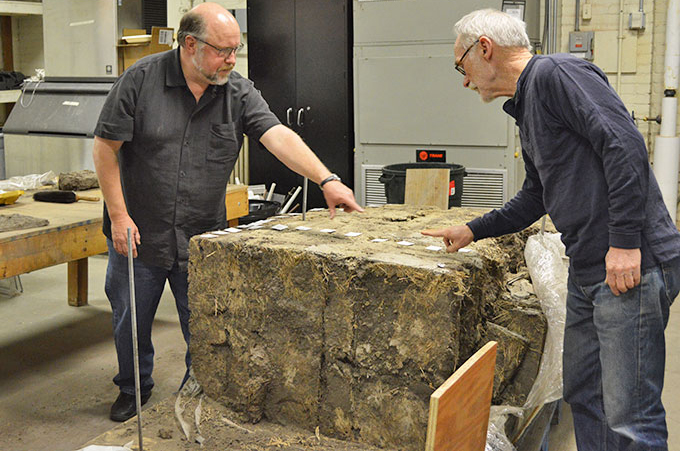
The little house on the prairie is not so little anymore.
A team of interdisciplinary researchers has begun analysis on part of a 110-year-old sod house that was once home to a group of Custer County, Neb. pioneers.
"This is the oddest project I have every worked on," said John Carter, senior research folklorist/associate editor at the Nebraska State Historical Society. "We have a lot of disciplines bringing together a lot of resources toward a central goal. Never in my life have I been a part of such a thing, nor have I ever had as much fun."
Built by Henry Eugene Chrisman in 1902 and 1903, the sod house was originally a three-room dwelling with exterior doors into each room. The house is unique in that no other with its plan has been recorded in Nebraska.
Two years ago, Larry Estes, whose family owns the sod house, contacted archaeologists at the historical society to survey the property.
"That is where I got involved," Carter said. "I have a long and deep interest in sod houses, as they are not only cultural features on the landscape; they are part of the landscape."
Custer County is the "epicenter" of sod house construction, with more sod buildings there than anywhere else in North America, Carter said.
The project involves studying a 4-by-8-foot chunk of sod deemed the "sod wall," which was removed from the house in November 2013. Pete Stegen of NET produced a video of the teardown available at http://go.unl.edu/ghxe.
"I see these sod blocks as archived samples taken from a prairie in 1902," said Dave Wedin, professor of plant and ecosystem ecology in UNL's School of Natural Resources. "It's rare to find plant and soil samples that old. These samples can give us insights into how that prairie functioned over a century ago before the onset of modern agriculture and all the changes in our landscape."
For example, all native prairies in Nebraska now have several non-native species in them like brome grass and Kentucky bluegrass. Had these invaded yet in 1900? And if these archived prairie soils are compared to modern agricultural soils in that area, how much of the soil organic matter and fertility has been lost in 110 years?
Those are some of the questions Wedin hopes to answer with his sod wall research.
"New techniques allow us to ask new questions from old samples like these pieces of sod," Wedin said.
For Johnica Morrow, applied ecology doctoral student, the sod wall presents an opportunity to examine the pests that plagued the pioneers.
"Our lab is interested in studying ectoparasites, namely bed bugs and fleas, which may have lived in the walls of the sod house and fed on its inhabitants," Morrow said. "Studying the sod house will advance our understanding of historic ectoparasitism in the United States. Understanding the nature of bed bug populations in the past is important for understanding emerging outbreaks of bed bugs in contemporary Nebraska."
LuAnn Wandsnider, professor and anthropology department chair, said that as an archeologist, she's focusing on the way people interacted with – and were affected by – sod houses.
"I'm interested in how people use material culture – buildings, clothing – to communicate something about themselves, such as ethnic identity and effective community leadership," Wandsnider said. "In Custer County, with its incredible ethnic diversity of homesteaders, we have a chance to see how sod houses were used in this capacity."
Back at the historical society, David Murphy, senior research architect, said studying the sod wall will shed light on his existing research that focuses on the history and theory of architecture in Nebraska.
"The deconstruction of the sample will allow me to record the coursing of one wall in detail, and perhaps allow me to devise a reliable, noninvasive recording method for the coursing of other standing structures," Murphy said. "Several results of the research we do on the sample will directly inform my current work on sod house antecedents, history and construction."
And that's just the beginning.
Anyone interested in exploring research opportunities with the sod wall is invited to contact Wedin at 472-9608 or dwedin1@unl.edu.
"I see this project as an example of citizen science and relish the opportunity to work with the public in Custer County," Wandsnider said. "Also, I appreciate the chance to work with colleagues across disciplines, especially on East Campus, because of the emphasis there on 'science with a purpose.'"
— Mekita Rivas, Natural Resources